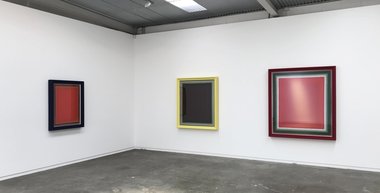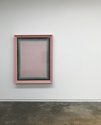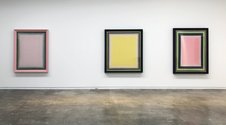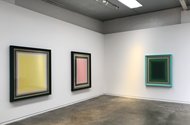John Hurrell – 8 November, 2017
Sometimes the front plane has modulated chromatic or tonal recession achieved through a sequential layering of very thin paint: dark or delicately pale. To this illusion the transparent acrylic brings a reflective surface and a slightly distorting curvature. It is a bit like Francis Bacon's use of glass to emphasis the presence of the peering viewer gazing at his oil paintings. In both cases it is about portraiture, in painted content and in rectangular proportions.
Auckland
Tomislav Nikolic
How long must we live right before we don’t even have to try
12 October - 11 November 2017
It is about four years since Tomislav Nikolic last had a solo show at Fox Jensen McCory, and although he has been in several group shows, his paintings have undergone some significant changes. They are bigger now, a little more complicated with their use of painted planar edges and concentric illusory frames, and are presented float mounted behind clear shrinkalight acrylic, bordered by simpler wooden frames, without baroque scalloping or ornate botanical motifs. Only vertical or horizontal grooves.
With bold botanical colours around their borders, they are noticeably more physical as rectangular forms, being quite imposing and distinctive, especially with strident colour combinations. They have dark troughs from where the canvas is isolated in ‘suspension’—to hover as a separate rectangle within the edges of the frame—and the sides of that canvas are often gilded, with a thin glowing line (say, orange or fluoro lime) around the edge of the front plane.
Sometimes the front plane has modulated chromatic or tonal recession achieved through a sequential layering of very thin paint: dark or delicately pale. To this illusion the transparent acrylic brings a reflective surface and a slightly distorting curvature. It is a bit like Francis Bacon’s use of glass to emphasis the presence of the peering viewer gazing at his oil paintings. In both cases it is about portraiture, in painted content and in rectangular proportions.
Of course in Nikolic‘s case it is about sculpture too, and the movement of the viewer towards and away, to the left and the right, of the complicated frame—and the way that device sits on and casts reflected light back onto the wall. You are expected to really investigate the vertical and horizontal elements as narrow planes of paint covered surfaces, and that draws in the architecture of the room. The total work is not hovering suspended at eye-height in isolation, but solidly embedded as a fixture, organically and optically fastened to the walls and the interior of the building.
John Hurrell





 Two Rooms presents a program of residencies and projects
Two Rooms presents a program of residencies and projects Advertising in this column
Advertising in this column



This Discussion has 0 comments.
Comment
Participate
Register to Participate.
Sign in
Sign in to an existing account.